I started early, before anyone else was awake, driving out to the garden at the Ness Farm.
They are on vacation for the weekend so I fed and watered their chickens. They are looking good. The rooster we gave them is still there, though segregated in his own small run. Lance was going to butcher him after it had started attacking the hens but that was a couple of weeks ago now. Wondering if they are going to give him another chance when the hens are larger. He is a really beautiful rooster. Too bad he didn’t get along well with others after how gentle he was for us.
The flour corn out there is drying down more, and I would guess I will harvest nearly all of it next week. I did pick what had dried down so far and it is all still looking good. It is fun to see the different genetic attributes it has. Red blushing on some ears. The ones that do have a larger butt section on the cob. I find this in photos taken by Oscar Will back in the 1800’s. Good ear length. Most are 8 row cobs. A few 10 row cobs, though those have slightly smaller kernels.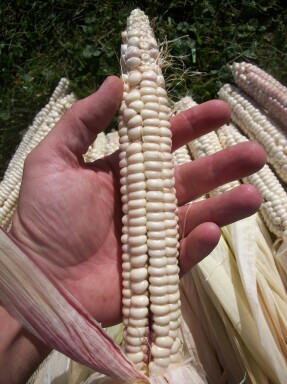
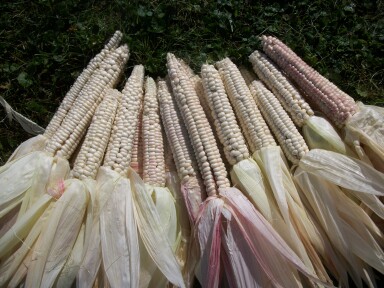
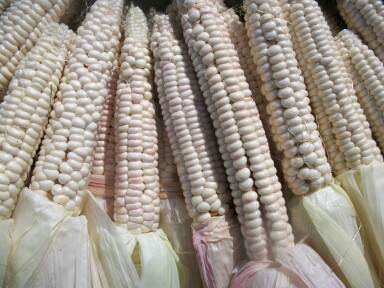
Next thing to pick there was beans. There are two long rows of mostly Dragon Tongue beans. A few plants did not come back true to type, which means I got a cross in there somewhere last year (though I am not sure with what) which has given a pole type that has crawled over the Dragon Tongue beans. They taste fine. Only picked one row and it gave me a full grocery bag full of beans. Nice to see. Beans had done squat up until now. In the extreme heat of July, when they would normally be producing, all the plants did was flower and drop flowers. It is a crush now, getting tons, but I was afraid I would not get any.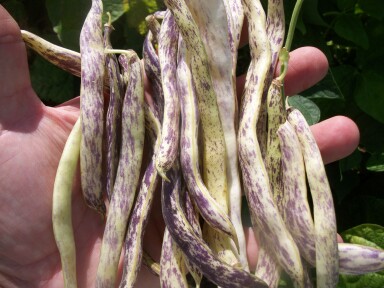
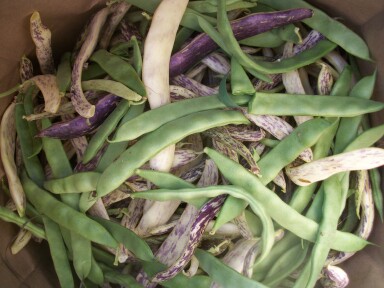 I also found a half dozen summer squashes out there which was enough to refill the dehydrators back home. What I have picked so far has reduced down to just two gallons of dried squash. Amazing how little space the stuff takes up when you remove all of the water from it. Nice as well how it re-hydrates in soups and stews.
I also found a half dozen summer squashes out there which was enough to refill the dehydrators back home. What I have picked so far has reduced down to just two gallons of dried squash. Amazing how little space the stuff takes up when you remove all of the water from it. Nice as well how it re-hydrates in soups and stews.
After the Ness Farm I drove home, dropped off what I had harvested up to that point, set up the dehydrators, got some more bags and headed over to the Minnetonka garden. That was one of my primary tomato and potato gardens. The garden looks great. It has produced very little. This has been a poor summer for tomatoes overall, and the potatoes at this garden were decimated by Colorado Potato Beetles. I found about a gallon of San Marzano tomatoes, which seem the least ill-effected by the weather. From the number of plants there, that is what I should be getting per plant. I got a half dozen other tomatoes of various kinds which I left with Marc who lets us use his garden.
The grow-out of Victor Kucyk’s 2175 dent corn is starting to dry down. Considering there was only two rows and I hand pollinated none of it the ear development is pretty good. The gene pool behind this corn is 50% Painted Mountain, and there are a couple of old northern flint varieties in it as well. Supposedly it tests out in excess of 14% protein, and from a conversation with Victor I had, they are crossing more varieties into it in hopes of getting it close to 20%. Regardless, it is a much prettier corn than what you usually find in mono-cropped garbage GMO fields.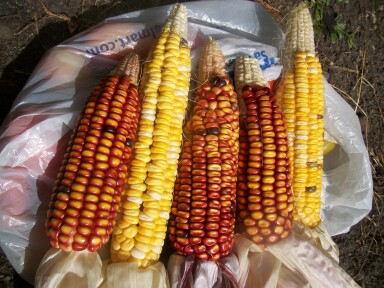
The pole beans at this garden are also finally producing. 20 feet of trellis gave me another grocery bag full of beans. This time Purple Podded Pole, and Golden of Bacau. I do love the not-green beans. So much easier to find and pick. Generally taste better too.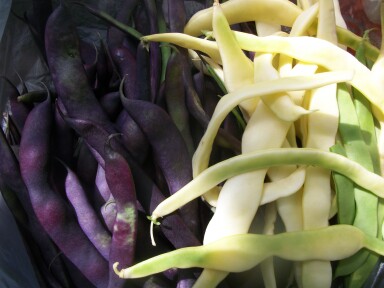 I had a pitch fork along and I dug into a half dozen of the potato hills. For the most part the defoliated tops have dried down and I could harvest it all, but the watermelons I interplanted with the potatoes are sprawling over many of the hills and I will leave them alone until after the watermelons are done. They have now suddenly set some fruits, though I am not sure how big they will get here at the end of the summer. This was the one that was supposed to give me watermelons in excess of 20 pounds. Doesn’t seem likely at this point. The melons that have set are no bigger than a baseball now. We will see.
I had a pitch fork along and I dug into a half dozen of the potato hills. For the most part the defoliated tops have dried down and I could harvest it all, but the watermelons I interplanted with the potatoes are sprawling over many of the hills and I will leave them alone until after the watermelons are done. They have now suddenly set some fruits, though I am not sure how big they will get here at the end of the summer. This was the one that was supposed to give me watermelons in excess of 20 pounds. Doesn’t seem likely at this point. The melons that have set are no bigger than a baseball now. We will see.
The potato hills themselves were a mixture of disappointments. Of course none of them did well. The best hill had maybe 2 pounds of potatoes under it, the worst had four 1 ounce potatoes (an all-blue which looked like pebbles in the dirt and you had to feel by weight to realize they were not stones) which is not real encouraging, but the half dozen hills gave up about ten pounds of potatoes. There is 100 hills there so I will get some, but not enough to really give a lot away.
I stopped at Frank Calta’s on my way home and gave him the bag of San Marzano tomatoes. He has done much of the tending at this garden and he deserves them. He had stopped at a market in Saint Paul that morning and picked up a mixed bushel of tomatoes to make into sauce. Had a nice conversation with him and a couple bottles of hard cider before I headed home.
Once home I put a fire under my big pasta boiler. It has a strainer insert and I figured it would be a good way to blanch beans. Worked like a charm. I had two large bowls in the sink with cold water. The one on the left was beans being rinsed. The one on the right was for cooling beans after being blanched. After rinsing I would fill up the pasta boiler with beans (water was already boiling) and after 90 seconds lift the beans out, dump them in the cold water (with more cold water running in) put more beans in the boiler, and pack the cooled beans in pint freezer bags. In this way I was able to process 32 pints of beans and get them all in the freezer in under an hour.
When I was done with the beans I took out the insert and washed the pasta boiler out. It has a nice heavy bottom which is essential for not burning things when cooking them down. I cut all of the Czech Bush and New Big Dwarf tomatoes, seeded them into fermenting jars, and pureed them. That gave me about two and a half gallons of puree. Into the pasta boiler went a crushed and diced head of Music (thanks Tug) garlic along with about a quarter cup of olive oil. Once the garlic was sauteed I poured in the puree.
Out in the gardens here at the house I had Rumi Banjan, Nell’s Sweet Heart, and Cherokee Purple tomatoes ready to pick. Between those I had three more jars of seeds fermenting and another gallon of puree cooking down on the stove with garlic and olive oil. By the time it finished, topped off with fresh basil, I had 11 more meals of red sauce put away.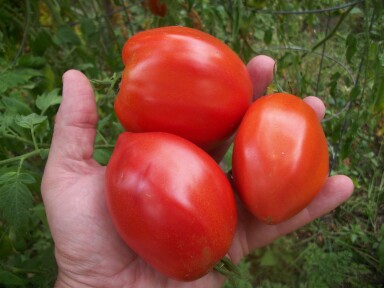
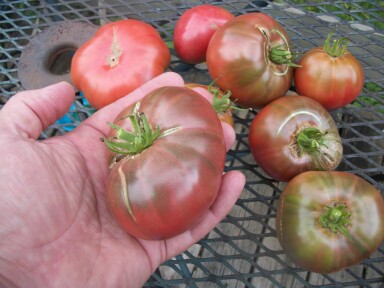
In the middle of all of this I had taken a couple of venison shoulders out of the freezer upstairs to make room for the red sauce. By the time the sauce was going in the freezer the meat was soft enough to slice. It came to about 10 pounds of meat, and I cut it into reasonable size pieces, packed it into the slow cooker with garlic, molasses and soy sauce to cook over night. I will pack that into single meal packs and re-freeze it with the broth for soups. There is enough connective tissue in that meat that it really needs to be either ground up, or cooked until the connective tissues break down. It will be a nice quick addition to soups without a need to start cooking the day before to eat it.
Of course, while I am writing this, it is Sunday morning and not very early any more. Patti is laid up with a migraine and I am trying to get the kids to quietly clean their room, which has taken ….. quite a while. I need to get out to the Ness farm again and I think I am going to have to take all the kids with me so the house is quiet for her. She has never had morning sickness in any of her pregnancies. What she gets are headaches. Can’t be fun.


GREAT PICTURES OF THE CORN!!! I love the iroquois flour’s look. SOOO white. To have an idea about the relative content of the corns one to another, a good estimate can be made by slicing a kernel in two across its width ( left to right, not back to front when on a table) and look at the size of the germ. Most of the protein is there. I never thaught of dehydrating squah…great idea,
Keep up the good work my friend
calling me a psychopath is kinda inroic…I mean you claimed that I’m a government stooge who is only here to cause chaos…You claimed I have created undue mental stress on you because you think I’m going to kill you…You have threatened me with legal action…You have claimed that others are impersonating me…You claim that all anons wear masks and thus should be discounted, and are cowards…And now the latest is that you think Eric himself is spending to much time in his comment section and not working on his master thesis…And you call me the psychopath…I swear the deaf and blind never stop amazing me over their stupidity…
Yes, cook the bacon first to cook off the fat, or your soup will be fatty and your bacon limp. If you used dried beans, you will definitely need to add liuqid. The beans need something to soak up. I’d add liuqid until your beans are covered at least, and probably more. You can always cook it down later if there’s too much liuqid, but if there’s not enough, you’ll just have a burned mess.
Some things like your totamo problem can be fixed by fiddling with the camera use a tripod and a longer exposure so the colors are more saturated, for instance, or endless fiddling with the white balance.My guess is that some of the problems with digital cameras vs film are due to stupid things where the designers tweaked things in one direction to compensate for something most users would do wrong, but did so in a way that seriously messes up certain other situations. For example, sometimes camera manufacturers anticipate that and really overdo it on the red. The effect is that that you see bright reds as very flat right up to #FF0000 and stopping there over a large area, because they have pumped it up (I don’t remember why they do this).My camera is also sometimes weird with violets, which makes me really want to find objects that are truly violet to test it on (i.e. high-frequency wavelength, not a mix of blue and red).Really, it’s a technology-still-distinguishable-from-magic problem. My fear is that the restricted gamuts of monitors are covering for the restricted abilities of cameras, and consumers are just putting up with it.
My recipe for green beans:Green BeansANY vaetiry of fresh green beans.Snap the ends off .both ends about 1/4 inchWash a couple of times.Put in large soup/stock pan .or crock pot/slow cooker.Add 2 ham hocks (NOT the smoked ones) ..OR a large ham bone .or neck bones .for seasoning.Add 1 large chopped onion.Peel and quarter 4 or 5 potatoes add to pot.Cover with water.Cook over high heat .reduce medium heat .cook until beans are tender ..adding water as needed ..3-4 hours .when beans are tender .cook to reduce liquid you don’t’ want soupy green beans stirring often to keep from sticking to pot.Remove bones .any fat from ham hocks.Serve wth your choice of meats ..cornbread/muffins/biscuits b butter ..fresh sliced tomatoes.Note: Can substitute canned green beans.
Lovely garden. I live in the mdldie of deer country but still havenever had problem with the deer. What I have problems with is raccoons. Any hints you have at keeping the masked bandits out of the garden would be greatly appreciated. Thanks so much.
only solution I know to raccoons is trapping them or shooting them. Upside to them is that they do taste good.